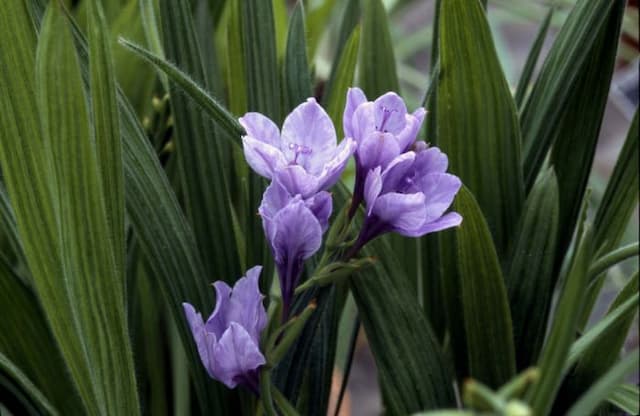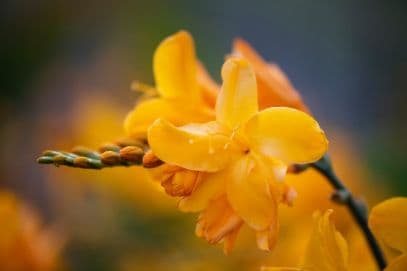Dutch Iris Iris 'Natascha' (Reticulata)

ABOUT
Iris 'Natascha' is a strikingly beautiful flowering plant, characterized by its ornate blossoms that showcase a delightful blend of colors. The flowers of this Iris 'Natascha', also commonly known as the reticulated iris, emanate an air of elegance and simplicity. Each flower typically consists of six lobes, which are artistically arranged in two distinct sets. The inner set of lobes, often termed standards, stand upright and are the most prominent feature when viewed from above. The standards typically boast a lighter shade, often a soft blue or lilac with delicate markings. Surrounding the standards, are the outer set of lobes, known as falls, which are distinguished by their broad, flaring shape that gracefully arches downward. These falls usually display a deeper hue of purple or violet and often exhibit a striking yellow or white pattern, particularly near the central portion where it merges into a slender, descending tongue, which may have a brush of orange or yellow. This vivid splash of color serves as a nectar guide, directing pollinators to the sweet rewards hidden within the blossom. Adding to the allure of Iris 'Natascha' is its foliage, a modest backdrop of slender, sword-shaped leaves. These leaves sprout from the base of the plant, forming a complementary, green cluster that frames and accentuates the floral display above. The foliage's vertical orientation juxtaposes elegantly with the flowers, allowing for a splendid contrast of form and color within the plant's overall structure. The harmonious combination of the reticulated iris's exquisite blooms, ensconced amidst the undemanding elegance of its linear leaves, crafts a picturesque sight in any garden.
About this plant
 Names
NamesFamily
Iridaceae
Synonyms
Natasha Dwarf Iris, Natasha Iris Reticulata
Common names
Iris 'Natascha' (Reticulata).
 Toxicity
ToxicityTo humans
The Iris 'Natascha' (commonly known as the Dwarf Iris) contains natural compounds which can cause skin irritation upon contact. If ingested, this plant can cause gastrointestinal symptoms such as nausea, vomiting, abdominal pain, and diarrhea. In severe cases, ingestion can result in increased salivation, lethargy, and other systemic symptoms. Care should be taken to prevent ingestion and contact with skin, especially in children and sensitive individuals.
To pets
The Dwarf Iris is considered mildly toxic to pets. If a pet ingests part of this plant, it can experience symptoms similar to those in humans, including vomiting, diarrhea, drooling, and abdominal pain. It is particularly important to prevent pets from accessing the bulbs of the Iris 'Natascha', as these can be more toxic than the leaves or flowers. Pet owners should exercise caution and keep their animals away from these plants to avoid potential poisoning.
 Characteristics
CharacteristicsLife cycle
Perennials
Foliage type
Deciduous
Color of leaves
Green
Flower color
White
Height
4-6 inches (10-15 cm)
Spread
4-6 inches (10-15 cm)
Plant type
Bulb
Hardiness zones
5
Native area
Turkey
Benefits
 General Benefits
General Benefits- Early Spring Color: The Iris 'Natascha' blooms early in the spring, providing a splash of color after the winter months.
- Compact Size: Its small, compact nature makes it suitable for borders, rock gardens, or container planting.
- Drought Tolerance: Once established, this iris variety can tolerate periods of drought, reducing the need for frequent watering.
- Low Maintenance: The Iris 'Natascha' does typically not require extensive care, which is ideal for gardeners of all levels.
- Attracts Pollinators: The flowers attract bees and other pollinators, which are beneficial for gardens and the environment.
- Pest Resistance: The plant is generally resistant to many common garden pests, ensuring fewer problems with insects.
- Cold Hardy: This iris can survive in cold climates, making it a good choice for gardens in temperate zones.
- Multiplication: Over time, the bulbs can multiply, enabling gardeners to divide and spread the plant to other areas of the garden.
- Decorative Seed Pods: After blooming, the plant produces seed pods that can add an interesting decorative element to the garden.
 Medical Properties
Medical PropertiesThis plant is not used for medical purposes.
 Air-purifying Qualities
Air-purifying QualitiesThis plant is not specifically known for air purifying qualities.
 Other Uses
Other Uses- Photography subjects: The distinct patterns and vibrant colors of the Iris make it an excellent subject for macro photography, showcasing the intricacies of its petals and structure.
- Artistic inspiration: The striking appearance of Iris 'Natascha' can inspire artists and be used as a model for paintings, illustrations, and other forms of visual art.
- Culinary decoration: Although not edible, the Iris 'Natascha' can be used as a non-toxic decorative element on plates and platters for special culinary presentations.
- Eco-friendly dye: Petals of the Iris 'Natascha' could potentially be used to create natural dyes for fabrics, offering a sustainable alternative to synthetic dyes.
- Perfumery: The essence of Iris 'Natascha' can be used in the creation of perfumes, capturing the flower's inherent fragrance.
- Education: This plant can be used in educational settings to teach students about botany, hybridization, and the specific care that Irises require.
- Garden design: Irises like 'Natascha' are often used in landscape design for their aesthetic appeal and ability to attract beneficial insects to the garden.
- Special events: Due to its beauty, Iris 'Natascha' can be incorporated into flower arrangements for weddings, anniversaries, and other celebrations.
- Crafts: Dried Iris 'Natascha' petals can be used in various crafts, such as making bookmarks, greeting cards, or potpourri.
- Cultural symbolism: Irises are a symbol of wisdom, hope, and trust, and can be used in cultural rituals or traditions to represent these themes.
Interesting Facts
 Feng Shui
Feng ShuiThe Iris is not used in Feng Shui practice.
 Zodiac Sign Compitability
Zodiac Sign CompitabilityThe Iris is not used in astrology practice.
 Plant Symbolism
Plant Symbolism- Faith: Irises commonly symbolize faith, holding a strong association with hope and trust.
- Wisdom: This flower is often linked to wisdom, regarded as a source of valued knowledge and guidance.
- Valour: In some cultures, the iris represents courage, celebrated for its ability to stand tall and firm.
- Hope: The iris is a symbol of hope, inspiring optimism for the future.
- Purity: With its pristine petals, the iris can signify purity and innocence.
 Water
WaterDwarf Iris should be watered thoroughly during the growing season, ensuring the soil is moist but not waterlogged. During the spring, when the Dwarf Iris is actively growing and blooming, you should aim to water about 1 inch of water per week, depending on rainfall. In the fall, when the plant is dormant, reduce watering significantly to prevent rot. It's key to avoid overhead watering to protect the delicate blooms from damage and to decrease the risk of disease.
 Light
LightDwarf Iris thrives best in full sun to partial shade. The ideal spot for this plant is a location where it can receive at least six hours of direct sunlight per day, as ample light encourages better blooms. Avoid deep shade areas, as insufficient light can lead to poor flowering and weakened growth.
 Temperature
TemperatureDwarf Iris prefers a temperate climate with a range between 35°F and 75°F. They can tolerate cold winters and are generally hardy to about -20°F, but they will not do well in extreme heat, especially when temperatures exceed 80°F. The ideal temperature range for thriving growth is between 50°F and 70°F.
 Pruning
PruningDwarf Iris benefits from pruning by the removal of faded flowers to maintain plant appearance and to prevent seed formation, which can drain the plant's energy. Prune back the foliage to the ground in the late fall after it has died back naturally. Pruning should be done annually, and the best time is post-flowering and before the onset of winter dormancy.
 Cleaning
CleaningAs needed
 Soil
SoilDwarf Iris 'Natascha' prefers well-draining soil with a pH of 6.0 to 7.0, incorporating sand and loamy elements to mimic its native rocky habitats.
 Repotting
RepottingDwarf Iris 'Natascha' should be repotted every 2-3 years to refresh soil and divide crowded bulbs, promoting healthier growth and flowering.
 Humidity & Misting
Humidity & MistingDwarf Iris 'Natascha' tolerates average outdoor humidity levels but does not require high humidity, making it adaptable to typical garden conditions.
 Suitable locations
Suitable locationsIndoor
Ensure bright light, cool temps, and good air circulation for indoor Dwarf Iris.
Outdoor
Plant in well-draining soil, full sun to partial shade for outdoor Dwarf Iris.
Hardiness zone
4-9 USDA
 Life cycle
Life cycleThe life of an Iris 'Natascha' (commonly known as Reticulated Iris) begins as a bulb, planted in late summer to autumn before the first frost. As winter ends, the bulb breaks dormancy and sprouts, typically with narrow, grass-like leaves and a singular beautiful flower stalk emerging in early spring. After flowering, the plant will enter a period of photosynthesis and growth, whereby the leaves synthesize energy to replenish the bulb for the next season. Once summer sets in, the foliage begins to die back as the plant enters a dormant phase, conserving energy within the bulb. During dormancy, the bulb can split or produce offsets, thus propagating new bulbs that may grow into individual plants. The cycle repeats when the bulbs reawaken the following spring, continuing the species' life cycle.
 Propogation
PropogationPropogation time
Late summer
The Iris 'Natascha', also known as the Dwarf Iris, is typically propagated through division of its bulbs. This process is best performed in late summer after the foliage has died back, indicating the plant has gone dormant. To propagate, gently lift the clump of bulbs from the ground using a spade or fork, being careful not to damage the bulbs. Once lifted, the bulbs can be separated by gently pulling apart any that are naturally coming loose from the main clump. Each bulb can then be replanted individually at a depth of about 4 inches (approximately 10 cm) and spaced 3-4 inches apart (about 7.5-10 cm). This form of vegetative propagation ensures that the offspring will be true to the parent plant, maintaining the delicate purple blooms characteristic of the 'Natascha' variety.









